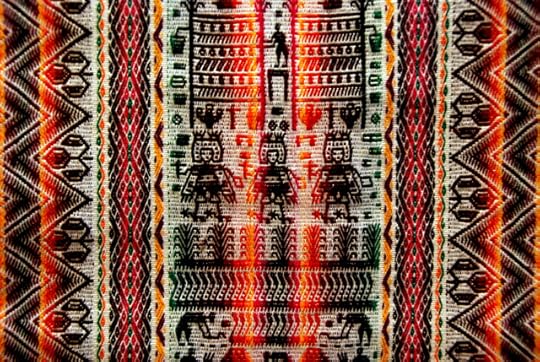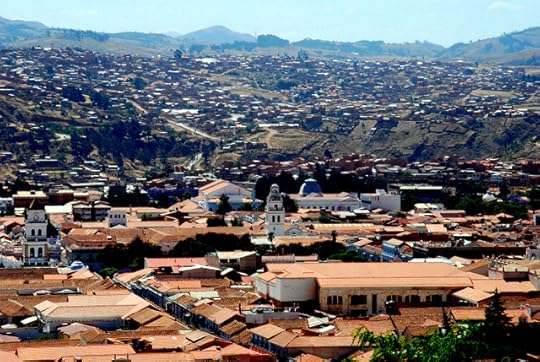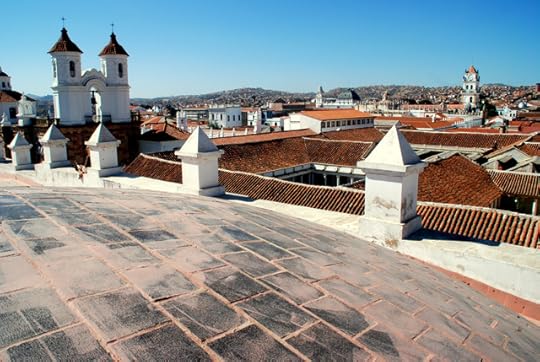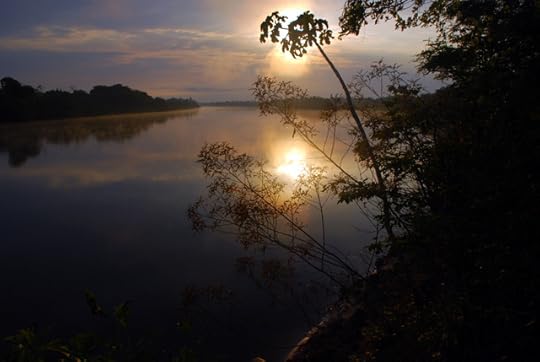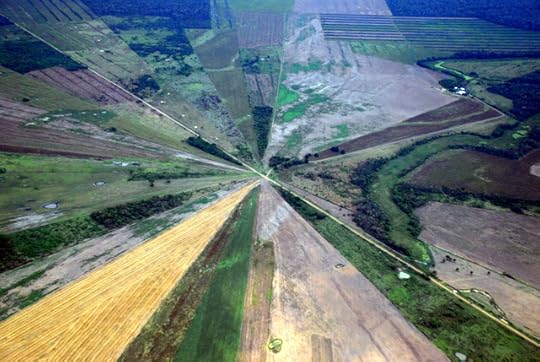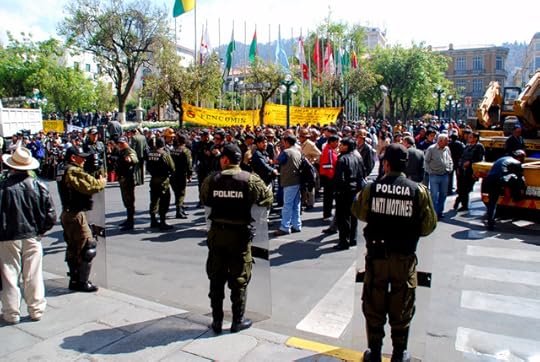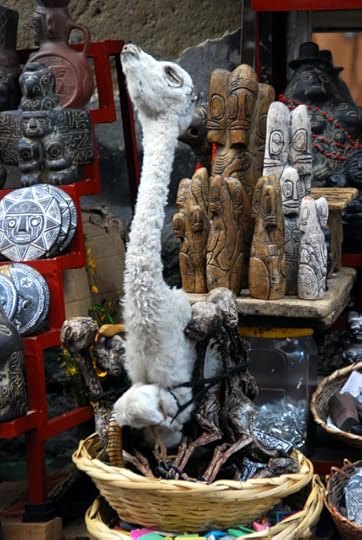Roderick Phillips's Blog, page 31
September 26, 2013
Indigenous Art Museum, Sucre, Day 60
The Indigenous Art Museum has revitalized the virtually lost art of weaving in Bolivia…
We begin our day at the rather hedonistic hour of noon. Our constant travel schedule is very tiring and we’re taking advantage of the fact that we have no obligations today for a very easy morning. My camera is not ready yet, the shop owner says. Come back at 4 pm. Sucre is now enjoying its siesta so we amble back to the hotel la Posada for another of their excellent lunch specials: fresh crusty bread, soup, Mexican chicken and chips, and delicious vanilla ice cream.
Next, we visit the Indigenous Art Museum (ASUR), which is unquestionably the real deal. This museum has revitalized and reinvigorated the virtually lost art of weaving for which the indigenous peoples from the surrounding Jalq’a and Tarabuco regions are historically famous. The museum highlights the evolution of weaving into an art form. Pieces can take more than two months to complete and they feature highly complex visual motifs. We will probably never encounter such exquisite and authentic textiles on our trip again so we delve deep into our pockets and purchase a beautiful design by weaver and artist, Teresa Flores from the Tarabuco region. There is an associated music exhibit, which is less appealing but the Tihuanaku (an important pre-Columbian culture and precursor to the Inca empire) artifacts dating back to 700AD are impressive. Two indigenous words I learn today are Aqsu (woman’s shawl) and unku (men’s shirt/tunic).
Later we return to the camera shop. The owner shakes his head and gives me back my camera – still broken. Spend the rest of the day soaking up the atmosphere and architecture of Sucre. Tomorrow it’s the evil sibling, Potosi.
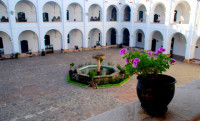

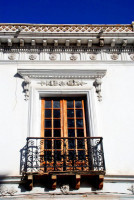
Posted by Roderick Phillips, author of Weary Heart – a gut-wrenching, heart-wrenching, laugh-wrenching tale
The post Indigenous Art Museum, Sucre, Day 60 appeared first on Roderick Phillips.
September 25, 2013
Cafe Gourmet Mirador, Day 59
We stroll to the Cafe Gourmet Mirador in the foothills of Cerro Churuquella today for views over the historic colonial center of Sucre. The views are wonderful as is the freshly squeezed OJ and the chocolates we demolish while we indulge in our decadent lifestyle. Sucre is just a gem of a city – up there with Cuenca as one of our favorites of the entire trip to date. On our return to downtown Sucre disaster strikes: my Tevas need some running repairs and a guy on the street with a sewing machine obliges. I take a quick snap of his handy work, but the camera slips from my hands and crashes to the floor. My heart skips a beat as I rescue it and assess the damage. A broken flash unit; it could have been much worse. A camera shop in town say they can fix it – maybe.
The main square in Sucre, the Plaza 25 de Mayo, is very busy today. First there appears to be a demonstration against the narcotics trade, then a very vocal parade of women and traditional bands. And finally there is a series of poetry readings. Christi and I lounge in the square eating more rich, delicious chocolates from some very fancy confectioners that dot the plaza and watch this odd assortment of entertainment. Such a decadent life.
Later we have dinner at the Joy Ride Café so that we can watch the documentary-cum-movie entitled, The Devil’s Miner. It’s the harrowing story of a 14-year-old boy forced to work in the dangerous Cerro Rico silver mines of Potosi where 8 million miners died over the last 450 years. The grim working class town of Potosi paid for Sucre’s expensive colonial make-over and the extravagancies enjoyed by the Spanish Empire for 200 years – and us!


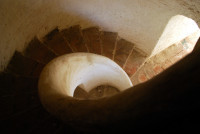
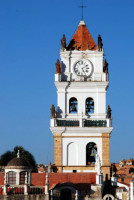
By Roderick Phillips author of Weary Heart – a gut-wrenching, heart-wrenching, laugh-wrenching ride.
The post Cafe Gourmet Mirador, Day 59 appeared first on Roderick Phillips.
September 24, 2013
Santa Cruz to Sucre, Day 58
This time we leave Santa Cruz from the city’s domestic El Trompillo airport in a comfortingly large and sturdy plane – my favorite. The flight to Sucre via Cochabamba takes 90 minutes and costs US$43; the bus, by contrast, winds its way tortuously through the mountains for 15 hrs and costs US$20. As much as we like to travel overland, this is seriously no contest. The flight from Cochabamba to Sucre is very short, yet so determined are TAM airlines to feed us that the flight attendant hands out the snacks as we board the plane. Can you imagine this happening on a domestic flight in the USA these days?
While the government sits in La Paz, Sucre is the constitutional capital of Bolivia. The city lies at an elevation of 2700m (8,858 feet) so it’s back to altitude after nearly a week in the lowlands. I can feel myself breathing heavily again, but at least I’m no longer a feast for the insects of NKMNP. Our new home is the French-run La Dolce Vita guesthouse, which has pleasantly appointed rooms – bright, airy, and stylishly modern. The host, Jackie, kindly explains the tourist attractions in Sucre and we begin with lunch at the hotel, La Posada. For less than US$5, the lunch special of fresh bread, pasta soup, beef stroganov, and a creamy desert is a steel and the surroundings are idyllic – colonial chic.
Indeed, Sucre possesses a well-conserved historic center featuring stunning colonial architecture that affords it UNESCO world heritage status. The best way to experience the colonial architecture is from the roof tops. First we visit the Templo de la Merced with its undulating multi-domed roof. Next we scamper around the exquisite Temple San Felipe Neri – part school and part church. It’s a beautifully maintained building with exquisite views over the hundreds of terracotta-tiled roofs that comprise historic Sucre.

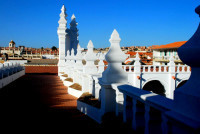


By Roderick Phillips, author of Weary Heart – a gut wrenching, heart-wrenching, laugh-wrenching ride
The post Santa Cruz to Sucre, Day 58 appeared first on Roderick Phillips.
September 23, 2013
Flor de Oro Day 57
Flor de Oro, originally a 5-star lodge, but now slowly deteriorating due to lack of maintenance, is cut out of the jungle and critters often wander through looking for food (tasty soursop is an abundant fruit around the place). During the early morning we spot tarantulas, frogs, and a monitor lizard. This is our last morning in NKMNP. A few days is simply not enough time to do justice to this magnificent national park. It would take months, perhaps a lifetime, to experience all the park has to offer. In that respect, Fernando, is a lucky man – as are his family who have made our stay so pleasant (Christi adores the fresh fruit drinks and simple, tasty food).
Our last excursion is through tall pampas grass, yet another component of the varied ecology in this park. In theory the pampas offers a better chance to glimpse some of the rarer mammals in the park, such as tapirs and anteaters. We walk to Orchid Island in searing heat. During the wet season (i.e. not now) the island is ablaze with flowering orchids. We do see thousands of arboreal bromeliads but sadly no large (or small) mammals.
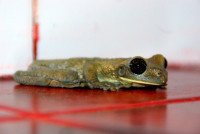
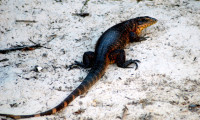
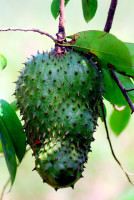



We return to Flor de Oro under dark, rain-filled skies. Cool off in the shower, pack, and eat a last lunch as the rain begins egged on by strong winds. Greg, our pilot, is not at all concerned, though. It’s another bumpy take off, but Flor de Oro quickly disappears from view – lost in a cloud bank that lingers all the way back to Santa Cruz. To be in such a small plane, buffeted by the wind, rain, and clouds, leaves me quaking in my boots. I, for one, am very relieved to touchdown safely in Santa Cruz. Thanks, Greg. Back at the Globetrotter hotel, our room, and its accompanying furniture, is larger and more eclectic than before. We even have a bidet. Surreal.
By Roderick Phillips, author of Weary Heart - a gut wrenching, heart-wrenching, laugh-wrenching ride
The post Flor de Oro Day 57 appeared first on Roderick Phillips.
September 22, 2013
Giant River Otters, Day 56
Highlight of the day: giant river otters…
A full day on the river today and I believe the plan is to follow the Itenez River downstream to its tributary, the Paucerna, and then follow that river upstream until it plummets off the Huanchaca Plateau at the Federico Ahfield and Arco Iris waterfalls (the falls we saw from the air on our flight to Flor de Oro). Hopefully, Fernando knows when to turn around, otherwise our Year of Wonder will end abruptly after two months. Communicating with Fernando is problematic, however, because he’s Brazilian and has limited Spanish. Le, our Vietnamese companion, speaks fluent English and some Spanish but finds Fernando’s accent difficult to understand. Christi and I, of course, speak neither Spanish nor Brazilian and consequently have little idea what’s going on.
Still, you don’t need great language skills when a wonderful wildlife encounter presents itself. Fernando spots a family of giant river otters swimming around some mangrove roots along the river bank. He whoops and whistles to gain their attention, while one particularly ear splitting call rouses the otters into a frenzy. We hang out here for ages enjoying their wonderful playful interactions.
We eventually find the Paucerna, and having signed the visitor book at the ranger station, we continue upstream. It becomes rapidly apparent, however, that there is insufficient water to allow our speedboat to progress very far and there is zero danger of us plunging over a waterfall to our deaths. Oh well. Quick point about speedboats and photography: they don’t mix very well so the only opportunity I have to take photos is when Fernando isn’t racing along like a madman. That guy certainly has a need for speed. Speed does have some advantages, though. The bloody mosquitoes can’t catch us and the oppressive heat and humidity is dialed down to bearable levels.
We retrace our steps to Flor de Oro, and perhaps as compensation for today’s disappointment, Fernando takes us out on another nocturnal boat safari. Even our pilot, Greg, who we haven’t seen for days accompanies us. The sky is clear and the stars are dazzling. Bats flutter past our faces, which is a little disconcerting. I yell, perhaps a little too hysterically, at one point when I’m hit in the neck – is it a vampire bat feeding on me? Thankfully not. It’s only a flying fish and several more find their way into the boat. They flop and flail on the floor until Fernando picks them up, kisses them (not sure why) and returns them to the river. More snakes, caiman, frogs, and toads keep us entertained during the safari.
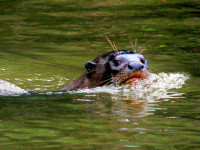
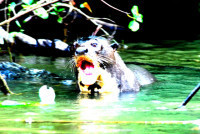

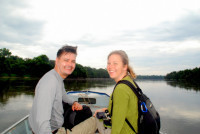
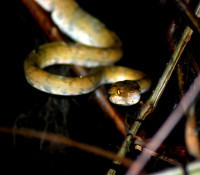

By Roderick Phillips, author of Weary Heart - a gut wrenching, heart-wrenching, laugh-wrenching ride
The post Giant River Otters, Day 56 appeared first on Roderick Phillips.
September 21, 2013
Night boat safari, Noel Kempff Mercado National Park, Day 55
A night boat safari at NKMNP is much more productive than the day safaris…
Thankfully this morning’s adventure on the river did not involve wrangling poachers, which gave us more time for animal spotting. I will tell you that spotting wildlife, let alone photographing it, in the jungles of South America is a lot tougher than on an African safari or in the Galapagos Islands. Jungle wildlife is skittish or it lives in the canopy or it’s just too darned small. So either bring a humungous lens or resign yourself to committing the experience to memory.
Having said that, the scenery is simply spectacular and we did spot a pod of playful Amazonian river dolphins during our morning boat ride while in the afternoon we see noisy howler monkeys as we traipse through dense jungle foliage. Funnily enough, there is an abundance of wildlife in and around Flor de Oro, which is actually easier to photograph (such as the crested caracara).
Tonight, Fernando, the enigmatic manager of Flor de Oro, takes us on a night boat safari. It is undoubtedly the most exciting thing we have done so far. With his strong beam of light, the night opens up before us. The wildlife may be expert at hiding during the day, but eye shine now reveals their hiding places and we spot frogs and toads, snakes, and caimans. Lightning streaks the distant sky and it’s an eerie feeling out here alone on the Itenez River.
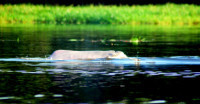
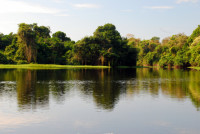
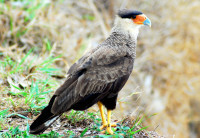
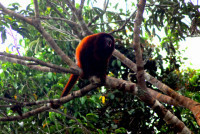
The post Night boat safari, Noel Kempff Mercado National Park, Day 55 appeared first on Roderick Phillips.
September 20, 2013
Itenez River, Day 54
The Itenez River forms a natural boundary with neighboring Brazil. And while NKMNP is about as remote as it gets in Bolivia, there are villages on the Brazilian side of the river. Fishing is a popular enterprise here and the Brazilian villagers often stray into tributaries and lagoons on the Bolivian side. One of the NKMNP park rangers, Umberto (who is based at Flor de Oro and who doubles as our guide as we speed along the river) stops periodically to chastise villagers for fishing illegally in Bolivian waters. This is a potentially hazardous activity because we never know whether the poachers are armed and dangerous.
Blue skies have returned to our little slice of paradise this morning, though, and the wildlife are enjoying the weather as much as we are. Umberto zooms up the river seemingly equally adept at spotting wildlife as poachers. Once he spots an interesting critter he hammers towards the riverbank. Not surprisingly, the startled and naturally skittish animal heads for the hills or at least the depths of the jungle (the Galapagos Islands, this ain’t). We suggest a more stealthy approach. It is in this way that we encounter that most archetypal of South American animals, the capybara, which is the largest rodent in the world. A large male capybara is happy to pose for photos – love it. Also spot a lot of birds including the Jabiru stork and some scarlet macaws.
Later we hike to a viewpoint and the bare rocks are so hot that the heat they radiate drenches us in sweat. We break for a picnic lunch at a nearby guard camp, Las Torres, and the chicken salad sandwiches and cold coca cola are absolutely delightful. I don’t think I’ve had a more refreshing glass of coke in my life. The most nerve-tingling moment of this first safari, though, occurs on our return boat ride when a magnificent jaguar slinking through the long grass at the river’s edge momentarily pops into view. Fortunately, Umberto (from a speeding boat note) locks eyes with the great beast and is able to point out the majestic creature to us (clearly less observant) tourists who stare open-mouthed until it retires quickly into the protective camouflage of the jungle. This encounter so quickly that I never had time to bring my camera up to my eye. Only in my mind’s eye do I see that magnificent creature over and over again. The sunset over the Itenez River is beautiful. In this solitary idyll all is peace and tranquility.
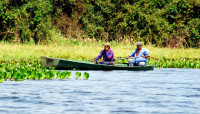
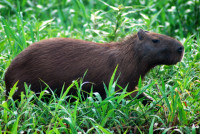
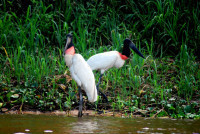
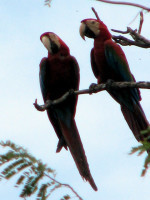

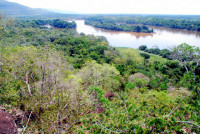
The post Itenez River, Day 54 appeared first on Roderick Phillips.
September 19, 2013
Noel Kempff Mercado National Park, Day 53
Noel Kempff Mercado National Park is an undiscovered gem. It’s not the easiest place to visit or the cheapest, but there will be abundant wildlife and virtually no tourists. Sounds like our kind of place. The southern section of the park is accessible by road, but the northern section can only be reached by air. And as there are no regular flights, Ruta Verde Tours charters a tiny 6-seater Cessna (and its pilot, Greg) to take us there. We leave from a private airstrip where not only our backpacks, but each of us is individually weighed before we board the plane. Le (shaved head, long, straggly beard) is the only other passenger; he’s from Vietnam. As we rumble down the grass airstrip, the plane is buffeted by side winds and the take-off is rather nerve-wracking. Once airborne we have great views over Santa Cruz and then we head north to Noel Kempff Mercado National Park (NKMNP); it’s a 2.5hr, 600 km flight. Down below we see extensive farming and cultivation in the lowland tropics with occasional islands of jungle vegetation. Some of the cultivation gives rise to interesting geometric patterns. The further north we go, the more sparse the human influence until all we see is tree upon tree so tightly packed that the ground is obscured (except for oases of open space). More that 2hrs into the flight we finally reach the iconic Huanchaca Plateau (150 km long, 50 km wide, and 300m high) that separates the northern and southern sections of the park and a series of huge waterfalls – not unlike Victoria Falls in Zimbabwe.
We land rather bumpily 30 minutes later at Flor de Oro airstrip and resort. The resort is run by a Brazilian guy, Fernando, and his family. Apparently, the complex owes its existence to drug traffickers who built the airstrip decades ago to transport cocaine from their clandestine laboratories. The resort has definitely seen better days and only a minority of the guest rooms are habitable. Having said that, our room is clean and there are towels, soap, toilet paper, and a fan (which is wonderful as long as the generator is on). Food is plentiful and tasty (fried catfish, rice, potato salad for lunch). Our arrival coincides with an amazing tropical thunderstorm that lashes the complex, curtailing our first planned hike. But at least the rain cools the temperature and removes some of the oppressive mugginess that smothers NKMNP. Flor de Oro is located on the mighty Itenez river and as night descends bats flutter by while frogs serenade us and tarantulas scamper in the shadows – and that’s just in the guest rooms.

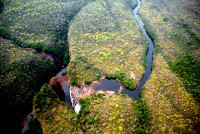
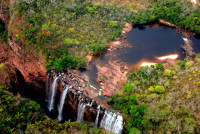
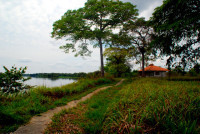
The post Noel Kempff Mercado National Park, Day 53 appeared first on Roderick Phillips.
September 18, 2013
Plaza Pedro D. Murillo, La Paz, Day 52
I cannot afford to dwell any longer on past failures because today begins the buildup to our next big adventure (there’s no dawdling on this Year of Wonder). But before we finally escape the insidious clutches of La Paz for Santa Cruz, the largest city in Bolivia, we just have time to explore the city’s cathedral in Plaza Pedro D. Murillo. When we finally reach the square, however, it is awash with police, security forces, and a large, noisy crowd of protestors. We think the rally has something to do with agricultural reforms, although it’s unclear (to us at least) whether the crowd is in favor or against the proposal. It transpires that adjacent to the cathedral is the presidential palace and incumbent Evo Morales is about to give a speech to his compatriots. The president arrives to great applause, but the crowd grows quieter the longer he speaks, so we skedaddle to avoid any potential trouble.
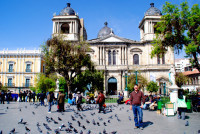
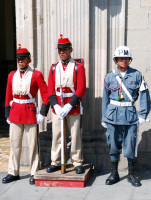

La Paz international airport is tiny, but they make a mean BLT. Christi and I sit contentedly in the O2 lounge, sucking up pure oxygen and feeling pretty euphoric. (I could have done with something like this on my ill-fated ascent of Mt. Parinacota). It’s an hour-long flight over the Andes to the muggy tropical lowlands of Santa Cruz. For a large city, the baggage claim procedures are fairly medieval, though. All the passengers thrust their baggage claim tickets in the direction of the handlers, hoping to attract their attention. The handlers then disappear behind a curtain and reappear, as if by magic, with a suitcase. I’m sure it’s entirely coincidental that those passengers offering the largest tip with their tickets are the ones who are served first.
Taxi to the fading charm of the ranch-style hotel Globetrotter. We get a huge, rather dilapidated, room filled with an odd assortment of juggernaut-size pieces of furniture. A few blocks from our hotel is the pretty, tree-lined Plaza 24 de Septiembre. Our LP guide suggests that the trees here are still home to the odd sloth so Christi and I amble over to check them out. We stumble around, peering up into the trees, and gesticulating wildly. We attract some very odd looks (or maybe we’re the odd ones), but alas we don’t spot any wildlife. Even at 9pm It’s hot and sticky in Santa Cruz and we risk the local ice-cream to help cool off. It’s de-licious.
The post Plaza Pedro D. Murillo, La Paz, Day 52 appeared first on Roderick Phillips.
September 17, 2013
Witches Market, La Paz, Day 51
It feels as if we’re becalmed in La Paz, a city that I have not warmed to at all. I’m still maudlin over my recent failure to climb Parinacota. I really thought I’d summit and I’m left to wonder was it me or was it my guide, Sergio? Was I not good enough or did he not care enough? To try and pull me out of my funk, Christi decides to show me around, beginning with the famous Witches Market. Fetuses, fetishes, and fabrics (colorful blankets and shawls, plus hats, scarves, and bags) sit cheek by jowl, attracting an eclectic mix of customers. The locals keep a wary eye on proceedings, and even when you think they aren’t looking, they instinctively know if you’re taking photos of them or their wares. And they approve of neither without payment. Perhaps there’s more to this witches markets than meets the eye.
Next up is the Plaza San Francisco. The square is a popular gathering place and many people are hanging out there, including some suspicious looking characters in ski-masks. On closer inspection, the ski-masked denizens are actually shoe-shine boys (or lustrabotas). Apparently they wear the masks to hide their identity, as lustrabotas face social ostracism for working on the streets, although there appears to be no shortage of customers making use of their services. The mask also represents a kind of badge of honor among the lustrabotas, who are some of the poorest people in La Paz. They possess few skills and sadly have zero chance of economic mobility. They earn a paltry 30¢ for each pair of shoes they shine. And I’m wearing Teva’s, today.
Iglesia San Francisco is the main highlight in the square. It has a classic baroque design, although the Aymara, who built the church in the 18th century, added some of their own stylistic flourishes to the façade, including extravagant floral patterns and symbolic figures (such as snakes, ceremonial masks, dragons, and birds).
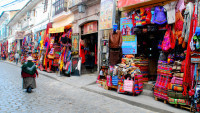
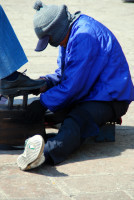
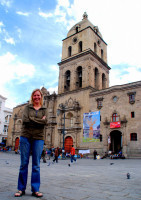
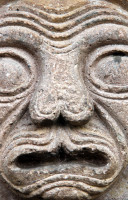
We risk Bolivian sushi for dinner. Not bad, and none of it comes back to haunt us, which is even better.
The post Witches Market, La Paz, Day 51 appeared first on Roderick Phillips.

